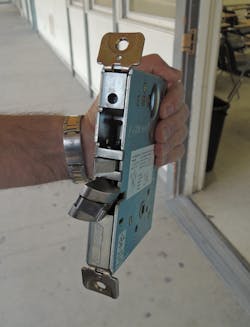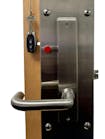After an attempted break-in by an armed intruder at an educational facility, school officials decided to upgrade to a Classroom Security Lock with an inside indicator.
This classroom door mortise lock installation is for an educational facility with multiple interior classrooms and outswing entry wooden doors on the exterior. The existing Schlage Classroom L9070 locks are ANSI/BHMA Function F05. The L9070 is a single cylinder, non-deadbolt mortise lock. The outside mortise cylinder locks and unlocks the outside lever. The door can only be locked from outside of the classroom. The inside lever is always free for immediate egress.
The replacement Classroom Security L9071 is a double cylinder, non-deadbolt function mortise lock built to meet ANSI/BHMA F32. A second mortise cylinder on the inside permits the lock to be locked from the interior. For this application, the latchbolt is retracted by lever from either side unless the outside is locked by key from either side. When locked, the latchbolt is retracted by key outside or lever inside. The inside lever is always free for immediate egress.
To complete the upgrade, Schlage offers the messaging indicator for the L Series mortise locks. The indicator visibly displays a 2" by ½" red “LOCKED” or white “UNLOCKED” message above the mortise cylinder. The indicator is available as an N Escutcheon or a Sectional Indicator. At this time, the N Escutcheon Indicator is available with a cutout to accommodate a mortise cylinder, with a built-in thumbturn, a built-in Cointurn or a built-in Emergency Key.
For this installation, the N Escutcheon Trim with the cylinder cutout was provided. The cylinder cutout provides the option to begin with a mortise cylinder, but to convert to a thumbturn mortise cylinder should the school administration consider eliminating the key in favor of permitting anyone within reach of the door to lock or unlock the outside lever.
For this installation, the decision was made to remove the existing mortise lock and trim, replacing it with a complete Classroom Security lock with Rhodes (06) levers. The existing lock had escutcheon-style trim on the exterior and interior. The new trim has the same dimensions as the existing trim.
Door prep was minimal. Since the existing and replacement mortise bodies are both Schlage "L", the only prep drilled was the turn hub, which is a ½" diameter hole on the interior door face. The opening is beneath the 1-1/4" diameter mortise cylinder crossbore opening. This opening accommodates the built-in driver that controls the indicator signal. The door had been cross bored at the mortise cylinder instead of just drilling the exterior.
After the existing lock was removed and the thumbturn opening drilled, the new mortise lock body was installed. The multifunction mortise lock body is capable of being configured to accommodate 9050/60/70/71 lock functions. On the outside of the lock case, a Schlage hand change label explains how to reverse the lock handing, while keeping the handing catch screw on the inside of the chassis.
The mortise case was inserted into the mortise pocket in the wooden door. Next, we made sure the opening in the new lock case aligned with the door prep. Two spring loaded spindles were inserted into the outside and inside hubs. Two mounting screws were started to keep the case in position and have sufficient room for adjustment.
The mounting plate is built into the outside escutcheon trim. The two mounting posts must be threaded securely onto the mounting plate, which can be rotated to accommodate door handing. The locksmith doing the installation used a battery-operated drill motor, tightening each post into the chuck to thread and tighten the posts, carefully as the mounting plate turns under pressure.
The outside lever attached escutcheon was mounted onto the door; making sure the two mounting posts slid through the openings in the lock case. When the escutcheon was flush, the inside spring cage was slid onto the mounting posts and the two Phillips Head screws were started.
Because the educational facility is keyed to a Best system, the mortise cylinders are longer than a standard mortise cylinder. This can present a problem. A 1-3/4" door is not thick enough to accommodate two Best mortise cylinders; the cams would contact each other. Installing compression rings permit the cylinders to extend out from the escutcheons while covering the edge of the faceplate for aesthetics and to protect against wrenching. A spring was placed beneath the compression ring and the outside cloverleaf cam equipped mortise cylinder was threaded into the lock case. Then the two escutcheon screws were tightened.
The indicator has red-locked and white-unlocked portions of the slide. When the trim is lifted vertical, the slide moves down, with red indicating locked. It is easier to install the inside indicator escutcheon with the lock locked. With the lock in the locked condition, mount the inside indicator equipped escutcheon plate starting the two Phillips Head mounting screws.
The inside cloverleaf cam-equipped mortise cylinder was mounted using a spring beneath the compression ring. The Phillips Head cylinder retainer screw was tightened and the inside and outside mortise cylinders were tested. The inside lever was installed using the Schlage Spanner Wrench.
When the outside or inside mortise cylinder is rotated to the locked position, the indicator will display the red LOCKED condition, notifying the people within the classroom that the outside lever is locked, restricting access. When either mortise cylinder is turned to the unlocked condition, the indicator will display white UNLOCKED.
As an alternative, an educational facility can upgrade existing Schlage Classroom Function F05 mortise locks to the Classroom Security F32 locks by installing a mortise cylinder equipped with a cloverleaf cam onto the inside of the door. An indicator can be installed using either an N sectional or rose trim.
A number of the high schools, colleges and universities opt for the escutcheon-equipped with the opening providing them a choice to use either a mortise cylinder for key operation or a thumbturn. This way depending upon the specific classroom circumstances, the inside can require a key to operate or can be operated by a thumbturn by anyone near the door.
Knowing if the door lock is locked or unlocked and having the capability of locking the outside lever without opening the door are important steps to "real world" security.






